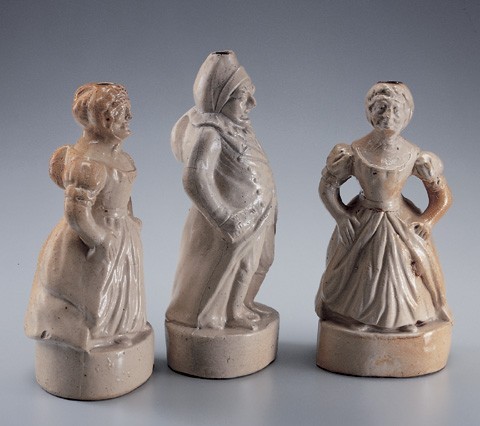
Gin flasks, Staffordshire, ca. 1840. Stoneware. H. of tallest: 8 5/8". (All objects from the Noël Hume collection unless otherwise noted; photography by Gavin Ashworth unless otherwise noted.) In collections of English brown stoneware gin flasks, a hump-backed hag is relatively common, but whether or not she represented Judy, wife to Mr. Punch, has been cause for prolonged speculation. Identifying Punch, himself (center), had never been an issue. Now husband and wife are unequivocally united by the paired flasks impressed with the name
and ownership of the same London Tavern (see fig. 2).

Detail of impressed marks on flasks illustrated in figure 1.
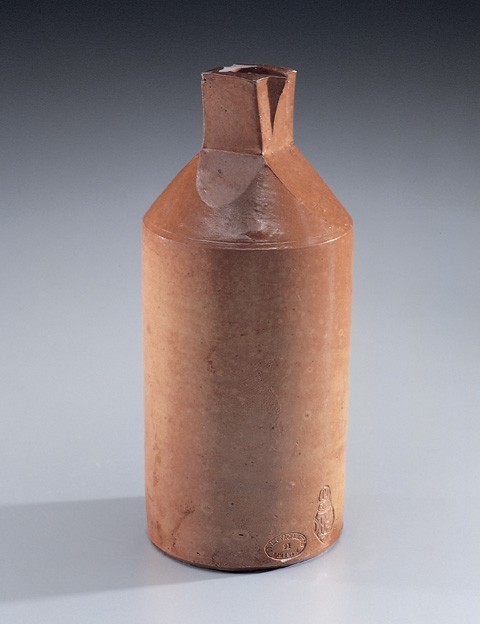
Ink bottle, Doulton, Burslem, Staffordshire, ca. 1899. Stoneware. H. 8". Doulton ink wells and bottles are a collecting field on their own. This example of a Stephens sheered-neck bottle has wider interest, serving as a reminder that diamond-shaped registry marks were applied to ceramics of all kinds across more years than the marks state. This example was registered in 1876, but the inclusion of the word LIMITED in the Doulton factory mark puts the bottle no earlier than 1899.

Detail of mark on ink bottle illustrated in figure 3.
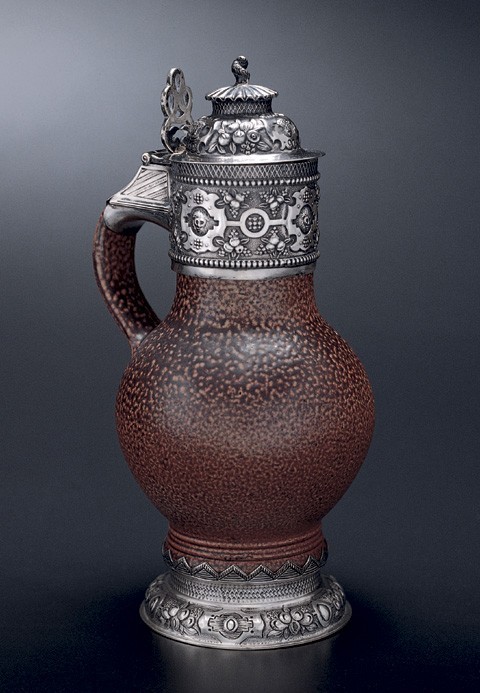
Jug, Doulton, Burslem, Staffordshire, ca. 1911. Stoneware. H. 11 3/4". This Rhenish-type stoneware drinking vessel with 1911 silver mounts was auctioned as dating from the seventeenth century, but when Colonial Williamsburg’s master silversmith George Cloyed temporarily removed the base, its true identity was revealed.
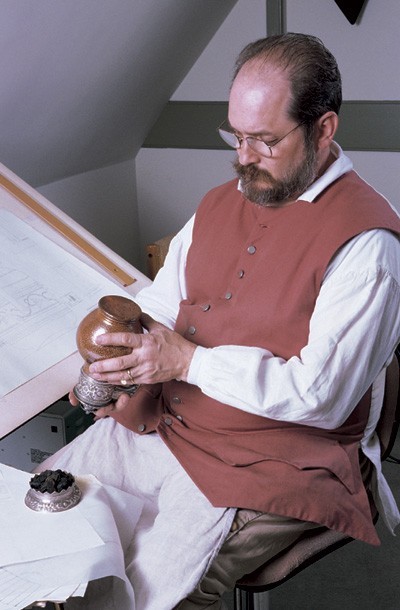
George Cloyed with the Doulton jug and removed silver base.

Detail of the revealed Doulton mark.

Jugs, Doulton, Burslem, Staffordshire, ca. 1911. Stoneware. H. of tallest: 6". Although Doulton’s fine wares have received much collector attention, the factory’s once common domestic and tavern lines have only recently begun to earn the interest they deserve. These examples made for Berkshire public house owners in 1911 illustrate the longevity of Doulton’s nineteenth-century “hunt jug” designs.
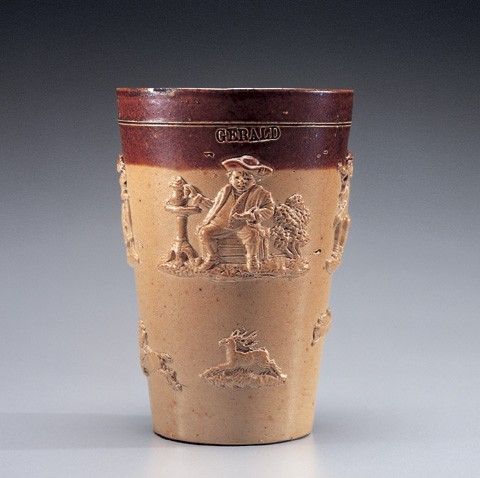
Beaker, Doulton, Burslem, Staffordshire, ca. 1880. Stoneware. H. 5 1/2". This personalized Doulton beaker has had the name impressed with individual letter dies, the “E” of which touched the wall before being applied, evidence of the continuing use of single-letter stamped inscriptions.
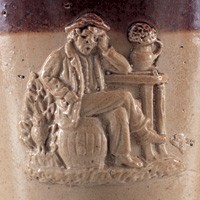
Examples of sprigged “toper” ornaments characteristic of Doulton’s Lambeth brown stonewares throughout the second half of the nineteenth century: left: the owl in the bush; center: a standard Toby Fillpot; and right: the cat-headed dog.
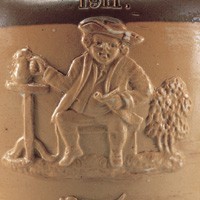
Examples of sprigged “toper” ornaments characteristic of Doulton’s Lambeth brown stonewares throughout the second half of the nineteenth century: left: the owl in the bush; center: a standard Toby Fillpot; and right: the cat-headed dog.
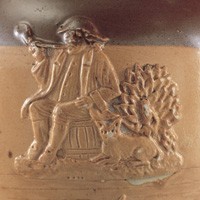
Examples of sprigged “toper” ornaments characteristic of Doulton’s Lambeth brown stonewares throughout the second half of the nineteenth century: left: the owl in the bush; center: a standard Toby Fillpot; and right: the cat-headed dog.
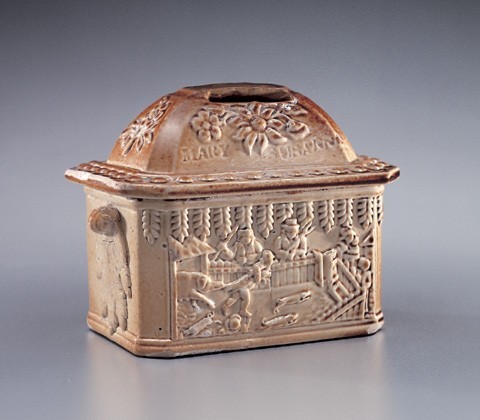
Bank, Samuel and Henry Bridden, Brampton, Derbyshire, 1840–1860. Stoneware. H. 3 7/8" (lacking finial). Front and back of a personalized, honey-brown stoneware money box. The purloined pig scene was thought to be a metaphor for piggy bank savings until it was discovered that the Briddens used similar molds for tobacco and butter jars. Broken off when the box was emptied, the finial may have been a sitting hen, a chimney stack, or a shell-shaped ornament.

Reverse of the bank illustrated in fig. 11.

A group of German stoneware wasters, Raeren, Germany, ca. 1550. Stoneware. H. 2 1/4". Said to have been intended to contain thread-lubricating oil to be hung around the necks of Flemish weavers, further investigation showed that these miniature costrels had many more uses.
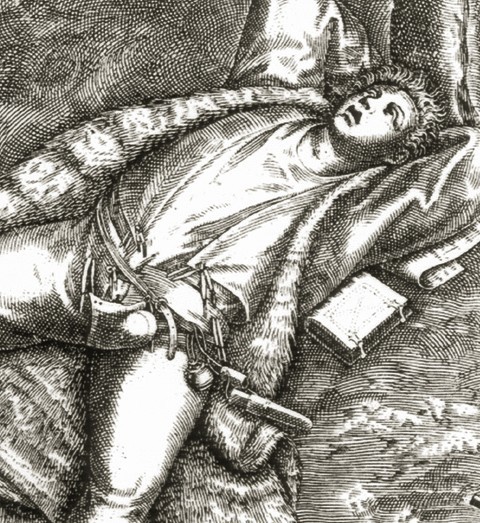
Detail from Peter Bruegel’s The Land of Cockaigne, 1567. This engraving illustrates a mini-costrel hanging beside a pen sheath at the waist of a sleeping scholar. There can be no doubt that the little bottle contained his ink or that such was its primary use.
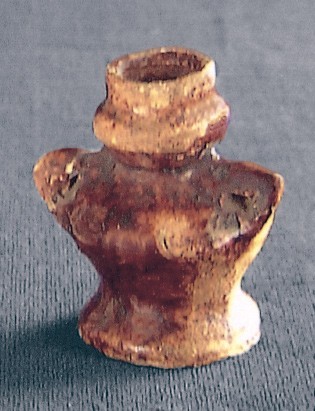
Ink pot, England, late sixteenth century. Earthenware. H. 1 7/8". (Courtesy, Jacqueline Pearce and the Museum of London; photo, Ivor Noël Hume.) A lead-glazed Border Ware copy of a Rhenish stoneware scriver’s ink pot.
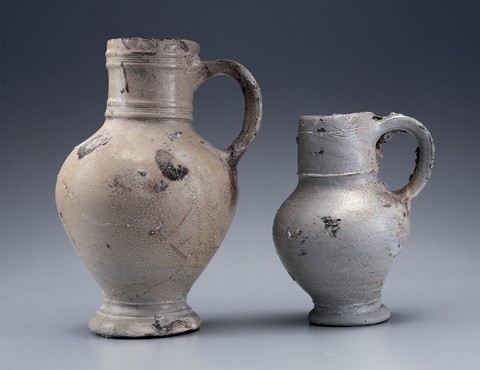
Examples of stoneware wasters, Raeren, late sixteenth century. H. of tallest: 9". From a Raeren kiln dump illustrating pear-shaped drinking vessel profiles that rarely found their way into the export market.
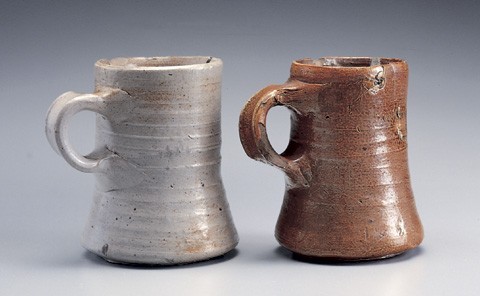
Mugs, Raeren, late sixteenth century. Stoneware. H. of tallest: 4 1/8". These semi-conical mugs from a Raeren kiln dump are another type uncommon in the export trade. The difference in their bases demonstrates the fallacy of drawing stylistic conclusions from too little evidence. One mug exhibits wire pulling marks and the other the result of seating on a sanded wheel.
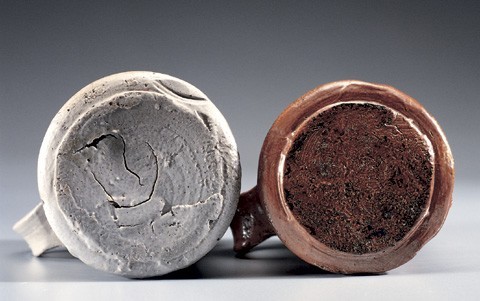
Bottoms of the mugs illustrated in figure 17.
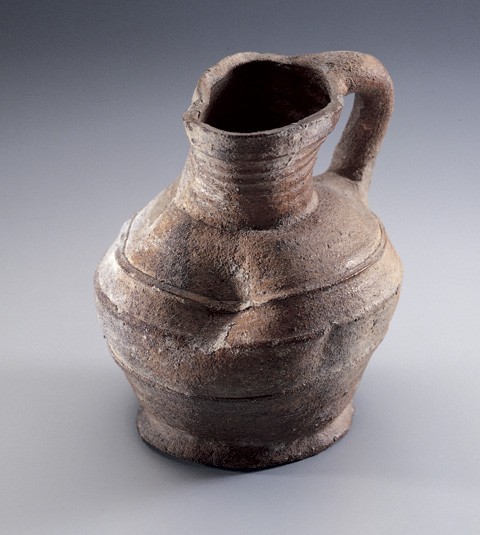
Jug, Germany, thirteenth century. Stoneware. H. 7". Collectors of Rhenish stonewares have hitherto shown little interest in the evolution of the ware through the medieval centuries. This example of Rhenish proto-stoneware, in spite of being wildly distorted and a potential waster, was reported to have been excavated in London.
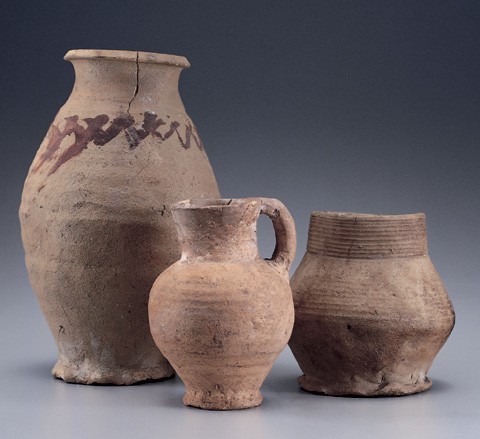
Examples of twelfth-century proto-stoneware. H. of tallest: 9 5/8". Left: from Pingsdorf painted with iron oxide; center: a pitcher in a similar ware from the Brunssum-Shinveld district of Dutch Limburg; and right: a mug of uncertain origin but attributable to the thirteenth or fourteenth century. All found in the Netherlands.
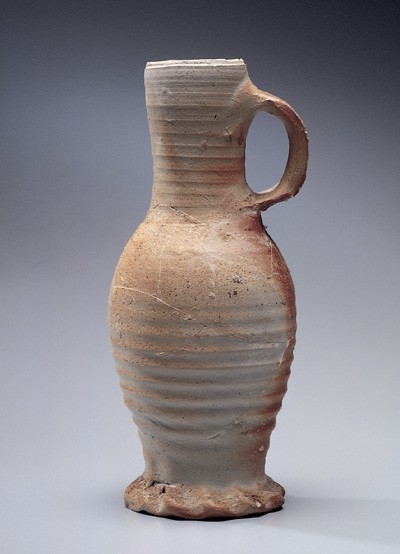
Jug, Sieburg, ca. 1400–1460. Stoneware. H. 8 3/4". Plentiful in the fifteenth century were the stonewares of Siegburg, one of whose shapes sports a curious and rarely explained name : Jacobakanne. The apocryphal association with the Countess Jacoba van Beijeren commemorates a remarkable lady around whom fairy tales could have been spun.
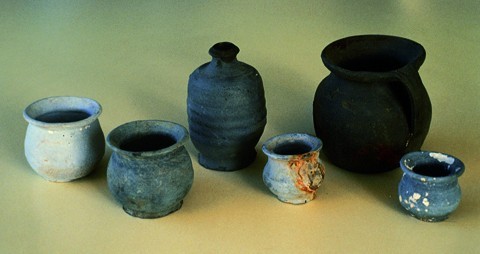
Examples of Normandy gray stoneware pharmaceutical pots and a bottle recovered from an unidentified shipwreck off the coast of Bermuda, ca. 1760. H. of bottle: about 3 1/2 ". (Collection of E. B. Tucker, Bermuda; photo, Ivor Noël Hume.)

Plates, Staffordshire or Yorkshire, 1775–1785. Creamware. D. 9 3/4". English creamware plates in the Royal shape decorated with an unusual version of the ubiquitous Chinese House pattern, their significance enhanced by their backs exhibiting the ghost images of two more from the same batch. Together, the four examples demonstrate the degree of painting freedom exercised between one plate and the next.
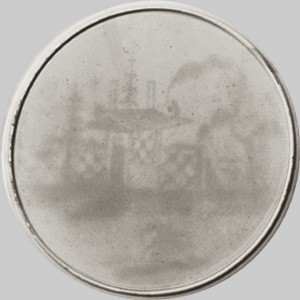
Backs of plates illustrated in figure 23. (Photo, Ivor Noël Hume.)

Backs of plates illustrated in figure 23. (Photo, Ivor Noël Hume.)
